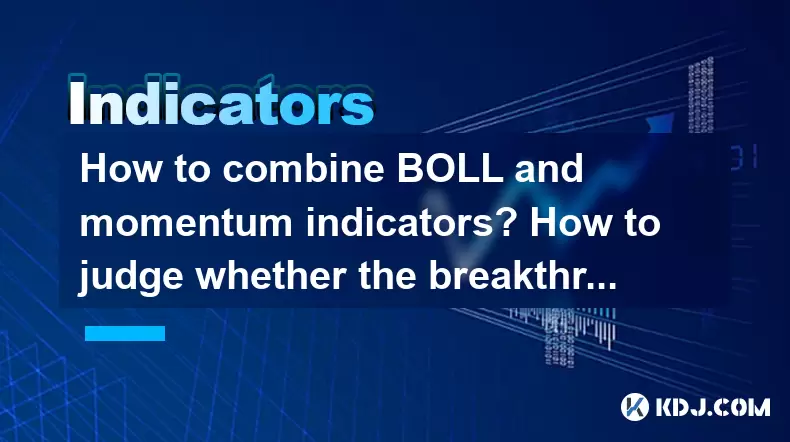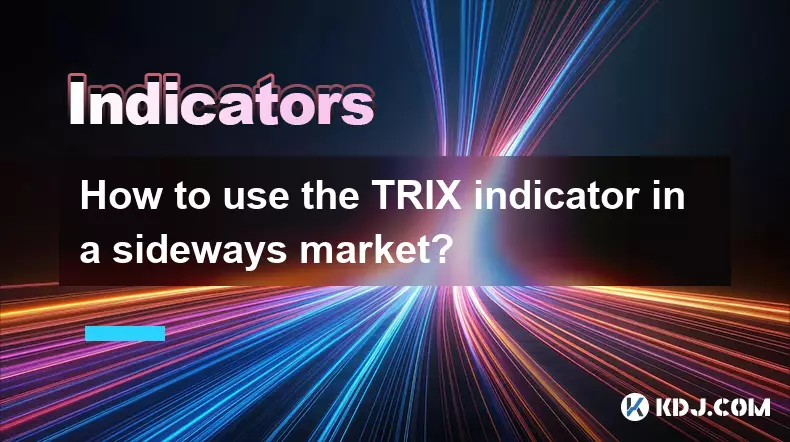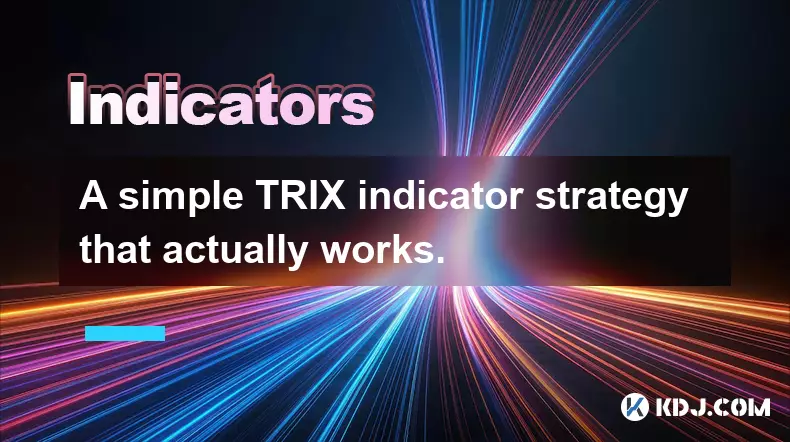-
 bitcoin
bitcoin $106680.127705 USD
0.67% -
 ethereum
ethereum $3615.722480 USD
-0.65% -
 tether
tether $0.999925 USD
-0.04% -
 xrp
xrp $2.550072 USD
5.91% -
 bnb
bnb $1002.572269 USD
-0.90% -
 solana
solana $168.746669 USD
1.08% -
 usd-coin
usd-coin $0.999832 USD
-0.03% -
 tron
tron $0.297244 USD
1.97% -
 dogecoin
dogecoin $0.182965 USD
0.71% -
 cardano
cardano $0.600432 USD
2.56% -
 hyperliquid
hyperliquid $41.439691 USD
-1.57% -
 chainlink
chainlink $16.548399 USD
2.40% -
 bitcoin-cash
bitcoin-cash $524.993680 USD
3.45% -
 stellar
stellar $0.302259 USD
4.10% -
 zcash
zcash $539.994871 USD
-16.31%
How to combine BOLL and momentum indicators? How to judge whether the breakthrough is strong?
Combining Bollinger Bands with momentum indicators like RSI or MACD helps traders confirm breakouts and identify strong trading opportunities in crypto markets.
May 22, 2025 at 01:08 pm

In the world of cryptocurrency trading, combining different technical indicators can provide traders with a more comprehensive understanding of market trends and potential entry or exit points. Two popular indicators that traders often use are the Bollinger Bands (BOLL) and momentum indicators. This article will explore how to effectively combine these two indicators and how to judge whether a breakthrough is strong, providing traders with actionable insights.
Understanding Bollinger Bands (BOLL)
Bollinger Bands are a volatility indicator developed by John Bollinger. They consist of a middle band, which is typically a simple moving average (SMA), and two outer bands that are standard deviations away from the middle band. The standard settings for Bollinger Bands are a 20-day SMA for the middle band and two standard deviations for the outer bands.
- Middle Band: This is usually a 20-day SMA, representing the average price over the last 20 days.
- Upper Band: Calculated as the middle band plus two standard deviations.
- Lower Band: Calculated as the middle band minus two standard deviations.
The primary use of Bollinger Bands is to identify overbought and oversold conditions in the market. When the price touches or moves outside the upper band, it might be considered overbought, and when it touches or moves outside the lower band, it might be considered oversold. Additionally, Bollinger Bands can help identify periods of high and low volatility.
Understanding Momentum Indicators
Momentum indicators measure the rate of change in price over a specified period. They help traders identify the strength of a trend and potential reversals. Common momentum indicators include the Relative Strength Index (RSI), the Moving Average Convergence Divergence (MACD), and the Stochastic Oscillator.
- Relative Strength Index (RSI): Measures the speed and change of price movements on a scale of 0 to 100. Values above 70 indicate overbought conditions, while values below 30 indicate oversold conditions.
- Moving Average Convergence Divergence (MACD): Comprises two lines, the MACD line and the signal line. A bullish signal is generated when the MACD line crosses above the signal line, and a bearish signal is generated when it crosses below.
- Stochastic Oscillator: Measures the closing price of a cryptocurrency relative to its price range over a specified period. Readings above 80 indicate overbought conditions, while readings below 20 indicate oversold conditions.
Combining BOLL and Momentum Indicators
Combining Bollinger Bands with momentum indicators can enhance a trader's ability to identify high-probability trading opportunities. Here’s how to effectively combine these two types of indicators:
- Identifying Breakouts: When the price breaks out of the Bollinger Bands, it indicates a potential trend continuation or reversal. To confirm the strength of the breakout, traders can use momentum indicators. For example, if the price breaks above the upper Bollinger Band and the RSI is above 70, it might indicate a strong bullish momentum.
- Confirming Overbought/Oversold Conditions: When the price touches the upper or lower Bollinger Band, traders can use momentum indicators to confirm whether the asset is genuinely overbought or oversold. If the price touches the lower Bollinger Band and the RSI is below 30, it might suggest a strong buying opportunity.
- Divergence: Look for divergences between the price and momentum indicators. If the price makes a new high but the RSI fails to make a new high, it could indicate weakening momentum, suggesting a potential reversal.
Judging the Strength of a Breakthrough
Determining the strength of a breakthrough is crucial for making informed trading decisions. Here are some methods to judge whether a breakthrough is strong:
- Volume Analysis: A strong breakthrough is often accompanied by high trading volume. When the price breaks out of the Bollinger Bands and the volume is significantly higher than average, it suggests strong market interest and a higher likelihood of the trend continuing.
- Momentum Indicator Confirmation: Use momentum indicators to confirm the strength of the breakthrough. For instance, if the price breaks above the upper Bollinger Band and the MACD line crosses above the signal line, it indicates strong bullish momentum.
- Sustained Movement: A strong breakthrough should be followed by sustained price movement in the direction of the breakout. If the price quickly reverses after breaking out, it might indicate a false breakout.
Practical Application of BOLL and Momentum Indicators
To apply BOLL and momentum indicators effectively, traders can follow these steps:
- Set Up the Indicators: Open your trading platform and add Bollinger Bands with the standard settings (20-day SMA, two standard deviations). Add your preferred momentum indicator, such as RSI or MACD.
- Monitor Price Action: Watch for the price to touch or move outside the Bollinger Bands. This indicates potential overbought or oversold conditions.
- Confirm with Momentum: Use the momentum indicator to confirm the strength of the signal. For example, if the price touches the lower Bollinger Band, check if the RSI is below 30 to confirm an oversold condition.
- Analyze Volume: Check the trading volume during the breakout. High volume supports a strong breakout.
- Execute Trades: Based on the combined signals from BOLL and momentum indicators, execute trades accordingly. For example, buy when the price breaks below the lower Bollinger Band and the RSI is below 30, and sell when the price breaks above the upper Bollinger Band and the RSI is above 70.
Examples of BOLL and Momentum Indicator Combinations
Here are some practical examples of how to use BOLL and momentum indicators together:
- Example 1: The price of Bitcoin touches the lower Bollinger Band, and the RSI is below 30. This indicates an oversold condition. If the volume is also high, it suggests a strong buying opportunity. Traders might consider entering a long position.
- Example 2: The price of Ethereum breaks above the upper Bollinger Band, and the MACD line crosses above the signal line. This indicates strong bullish momentum. If the volume is high, it suggests a strong breakout. Traders might consider entering a long position or closing a short position.
- Example 3: The price of a cryptocurrency makes a new high, but the RSI fails to make a new high. This indicates bearish divergence. If the price then touches the upper Bollinger Band, it might suggest a potential reversal. Traders might consider closing a long position or entering a short position.
Frequently Asked Questions
Q1: Can Bollinger Bands and momentum indicators be used for short-term trading?Yes, both Bollinger Bands and momentum indicators can be effective for short-term trading. Bollinger Bands can help identify short-term overbought and oversold conditions, while momentum indicators can confirm the strength of these conditions. Traders can use these indicators to make quick, informed decisions on short-term trades.
Q2: How often should I adjust the settings of Bollinger Bands and momentum indicators?The standard settings for Bollinger Bands (20-day SMA, two standard deviations) and common momentum indicators like RSI (14-day period) are generally effective for most traders. However, depending on the specific cryptocurrency and market conditions, you might need to adjust these settings. For example, in highly volatile markets, you might use a shorter period for the SMA or a higher number of standard deviations. It's important to test different settings and find what works best for your trading strategy.
Q3: Are there any risks associated with using Bollinger Bands and momentum indicators?Yes, like any trading strategy, using Bollinger Bands and momentum indicators comes with risks. False breakouts can occur, leading to potential losses. Additionally, these indicators are based on historical data and may not always predict future price movements accurately. It's essential to use these indicators as part of a broader trading strategy and to implement proper risk management techniques, such as setting stop-loss orders.
Q4: Can these indicators be used across different cryptocurrencies?Yes, Bollinger Bands and momentum indicators can be applied to various cryptocurrencies. However, the effectiveness of these indicators may vary depending on the specific cryptocurrency's volatility and trading volume. It's crucial to backtest your strategy on different cryptocurrencies to ensure its effectiveness across different market conditions.
Disclaimer:info@kdj.com
The information provided is not trading advice. kdj.com does not assume any responsibility for any investments made based on the information provided in this article. Cryptocurrencies are highly volatile and it is highly recommended that you invest with caution after thorough research!
If you believe that the content used on this website infringes your copyright, please contact us immediately (info@kdj.com) and we will delete it promptly.
- SEI Price Prediction: Reversal Target in Sight? What the Charts Say
- 2025-11-12 05:10:01
- BlockDAG, Mantle, and Tron: Charting the Course for Crypto Dominance in 2025
- 2025-11-12 05:20:01
- BlockDAG, Dev Incentives, and Crypto Investment: A 2025 Perspective
- 2025-11-12 05:35:01
- Decoding XRP: From Crypto Chaos to Global Liquidity Standard?
- 2025-11-12 05:25:01
- Coinbase, BVNK, and Stablecoins: A New York Minute on Crypto's Next Big Moves
- 2025-11-12 04:35:02
- Polkadot Builder Party: Social Signals and DOT's Market Momentum
- 2025-11-12 05:40:01
Related knowledge

What's the best way to learn the TRIX indicator?
Nov 10,2025 at 12:39pm
Understanding the Basics of the TRIX Indicator1. The TRIX (Triple Exponential Average) indicator is a momentum oscillator designed to filter out short...

How do professional traders use the TRIX indicator?
Nov 06,2025 at 04:40pm
Understanding the TRIX Indicator in Crypto TradingThe TRIX (Triple Exponential Average) indicator is a momentum oscillator used by professional trader...

Can I use the TRIX indicator on my mobile trading app?
Nov 07,2025 at 07:40pm
The TRIX indicator, a momentum oscillator designed to filter out short-term fluctuations and highlight long-term trends, has become increasingly popul...

How to use the TRIX indicator in a sideways market?
Nov 10,2025 at 03:00pm
Bitcoin’s Role in Decentralized Finance Evolution1. Bitcoin remains the cornerstone of decentralized finance, serving as both a store of value and a b...

How to code a simple TRIX indicator script in Pine Script?
Nov 07,2025 at 06:20am
How to Code a Simple TRIX Indicator in Pine Script The TRIX (Triple Exponential Moving Average) indicator is widely used in cryptocurrency trading to ...

A simple TRIX indicator strategy that actually works.
Nov 08,2025 at 05:39pm
Understanding the TRIX Indicator in Crypto Trading1. The TRIX (Triple Exponential Average) indicator is a momentum oscillator designed to filter out s...

What's the best way to learn the TRIX indicator?
Nov 10,2025 at 12:39pm
Understanding the Basics of the TRIX Indicator1. The TRIX (Triple Exponential Average) indicator is a momentum oscillator designed to filter out short...

How do professional traders use the TRIX indicator?
Nov 06,2025 at 04:40pm
Understanding the TRIX Indicator in Crypto TradingThe TRIX (Triple Exponential Average) indicator is a momentum oscillator used by professional trader...

Can I use the TRIX indicator on my mobile trading app?
Nov 07,2025 at 07:40pm
The TRIX indicator, a momentum oscillator designed to filter out short-term fluctuations and highlight long-term trends, has become increasingly popul...

How to use the TRIX indicator in a sideways market?
Nov 10,2025 at 03:00pm
Bitcoin’s Role in Decentralized Finance Evolution1. Bitcoin remains the cornerstone of decentralized finance, serving as both a store of value and a b...

How to code a simple TRIX indicator script in Pine Script?
Nov 07,2025 at 06:20am
How to Code a Simple TRIX Indicator in Pine Script The TRIX (Triple Exponential Moving Average) indicator is widely used in cryptocurrency trading to ...

A simple TRIX indicator strategy that actually works.
Nov 08,2025 at 05:39pm
Understanding the TRIX Indicator in Crypto Trading1. The TRIX (Triple Exponential Average) indicator is a momentum oscillator designed to filter out s...
See all articles









































































